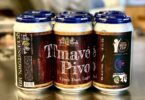Kevin Hart with a bottle of his Gran Coramino Cristalino Tequila
Cristalino Tequila is a type of Tequila that has been filtered through activated charcoal to eliminate the color imparted by wood aging. It is the fastest-growing category of Tequila today. After taking the Mexican market by storm, where it has proven to be particularly popular with millennials, especially millennial women, it is now making steady inroads into the US – Tequila’s largest market.
Recently, I sat down with Alex Coronado (AC), Master Distiller and Head of Production at Cuervo, to discuss two recent releases of Cristalino Tequila, Cuervo Tradicional Cristalino and Gran Coramino. The latter brand was founded by Kevin Hart, an American comedian and actor, and Juan Domingo Beckman, an 11th-generation Tequila marker and master distiller. Beckman is part of the family that controls Tequila Cuervo and serves as CEO of Becle S.A.B., the parent company.
JM: Cristalino Tequila is not yet a category officially recognized by the CRT, so for now, there are no rules regarding how it is made and what can be called a Cristalino. At what point will the CRT accept Cristalino as the fifth category of Tequila? What rules will be imposed regarding how Cristalino is produced, especially the use of oak chips and additives and the minimum age of the Tequila from which the Cristalino is made?
AC: As the founders of Cristalino Tequila over ten years ago – with Maestro Dobel Diamante – we are diligently working with other Tequila companies, the Mexican Government, and the CRT to legitimize the category and set criteria to regulate quality and process.
Every few years, the Mexican Norm revises what can be considered a Tequila, and for that to happen, there must be an agreement between private and public entities. As the fastest-growing category in Mexico, we see Cristalinos as an important innovation that broadens the appeal of Tequilas and offers drinkers a new and different way to taste and experiment with aged liquids.
While we work with the CRT and the Norm on formalizing the Cristalino category, we continue to innovate with our brands, most recently launching Jose Cuervo Tradicional Cristalino and Gran Coramino Tequila with Kevin Hart. These two brands will introduce a whole new US audience to what Cristalinos can offer, gaining additional credibility and awareness for the category.
JM: Traditionally, Tequila has a pronounced vegetative note on both the nose and the palate. This vegetative note ranges from green/fresh aromas like green bean, raw agave, asparagus or cut grass to more dryer, herbal notes like straw and underbrush.
The American palate, Tequila’s primary export market, generally doesn’t like vegetative notes, preferring sweetness, fruitiness, and smoothness. Many producers have emphasized these aromas and taste profiles in producing their Tequilas and have been quite successful in the American market.
Other Tequila brands with a more traditional aroma and taste profile, which emphasize Tequila’s vegetative notes, like Tapatio, have struggled to gain traction in the US. As the aroma and taste profile moves further away from the historical template, at what point does Tequila stop being Tequila?
Kevin Hart and Juan Domingo Beckman with a bottle of Gran Coramino Cristalino Tequila
AC: Tequila, as it tastes today, isn’t how it tasted over 100 years ago, when it was produced in the same manner as mezcal, so such “traditional” notes are more recent than most people know. Maestro Dobel Humito, one of our innovations, was created to bring back the taste of Tequila from the past when agave pinas were roasted with wood.
Tequila has evolved with changing production methods over time and the evolution of consumer preference and their palate. The beauty of Tequila is its versatility. You can live in both worlds by tasting more traditional flavors that you describe with Blanco variants.
In our case, Reserva de la Familia Platino and Gran Centenario 40 are some examples of what’s considered a classic Blanco, with strong herbal notes. On the other side of the spectrum, we have Tradicional Plata or Maestro Dobel Blanco, which have very different tasting notes, while still being considered Blancos.
We’ve also been pioneers with barrel aging, where consumers can experiment with Tequila’s much more complex side. We use multiple types of casks to produce different sensory experiences, like the whiskey category, such as toffee, coffee, cacao, dried fruits, sweet wine and more.
While flavors may change depending on various factors, from terroir, fermentation, cooking, distillation, aging and cask finishing, the liquid still maintains its integrity – it’s still Tequila. Its essence remains the same natural, raw materials of the agave plant that make it so unique a spirit.
JM: Along the same lines, cask finishing is becoming quite popular with Tequila producers. This practice is particularly true of finishing Tequila in casks that previously held sweet wines like Port, Sherry or Madeira.
These cask finishes introduce a far broader palette of aromas and flavor to Tequila than was previously the case. Does cask finishing dilute the character and legacy of Tequila, or is it simply a reflection of the industry adapting to ever-changing market conditions?
A bottle of Gran Coramino Reposado Cristalino
AC: The Tequila category is evolving. It’s growing up, and the agave and liquid have much more to offer consumers. In the past, Tequila had less quality control. Today, there are standards of quality and much tighter regulations, so quality has improved significantly.
Specific to maturation, Tequila behaves very differently when it touches wood than how a whiskey or cognac does – it’s more dynamic. This relatively new process opens a whole world of flavors to the category. Experimenting with different cask finishes is part of the fun and allows us to introduce expressions with surprising and unique flavor profiles.
Gran Coramino Cristalino is matured in new Eastern European oak barrels and then finished in Californian Cabernet wine casks, delivering a complex, deeply smooth flavor unique to the category. We don’t see these unique cask finishes as a departure from Tequila’s legacy but rather as a tool that adds an additional layer of complexity to the spirit.
Within Tequila, everyone’s preference is different, and it’s why we offer a broad range of Tequilas that employ different finishing methods to satisfy any Tequila lover – from classic unaged Blancos to complex Reposados, Añejos and Extra Añejos.
JM: The Tequila market is expected to continue to grow rapidly. Some estimates envision a five-to-ten-fold increase in the production of Tequila over the next 10 to 20 years. Can the industry produce enough agave to satisfy this potential demand, or will agave shortages become a recurring issue in the industry? Is there a significant risk in relying on such an extensive agricultural monoculture that diseases like the fusarium blight from the 1990s could emerge and devastate the agave crop?
AC: As the leader in the Tequila category, it’s important that we are good stewards of the land of Tequila to ensure the longevity and fruitful harvest of the agave plant for generations to come. We employ various methods in our agave fields to maintain the health of the land, including rotating the crops planted in our agave fields so as not to exhaust the soil and repurposing agave fiber as compost in our fields. We’ll continue to evaluate methods to ensure the longevity and health of the agave crop.
One of the main reasons we’ve seen agave go from shortage to surplus during several cycles is the lack of planning and integration from most companies. There were few agave shortages in the past because distilleries planted and owned their own agave and were responsible for their own supply. Over time, we’ve seen an avalanche of new Tequila brands and companies storm the market irresponsibly, looking at short-term gains and using up a large amount of agave that they didn’t own or plan for.
Often, when you buy on the open market, these agaves haven’t reached full maturity, and the sugar yield is low. It’s understandable since prices are high, and most farmers live from day to day. As the company with the largest owned agave supply, we encourage all Tequila brands and distilleries to have a much more responsible approach, to invest in the land and the people that provide us with this precious raw material as we do. We are proud to have done this for over 260 years.
JM: The use of third-party distilleries to produce Tequila for independent brand owners has resulted in an explosion of new Tequila brands and a proliferation of taste and aroma profiles. While not new, this phenomenon is more widespread than it has ever been before. Is the massive increase in Tequila expressions good for the industry? Does it drive demand and an expansion of the marketplace, or does it confuse consumers who have little basis for differentiating one brand from another?
Jose Cuervo, Tradicional Cristalino Tequila
AC: The more people and companies that invest in the Tequila category, the more it allows for experimentation and gives consumers a variety of options to fit their preferences. Unfortunately, most of those brands are manufactured by the same two or three distilleries, so consumers are basically tasting the same liquid inside hundreds of bottles that range from under $30 to over $200.
It’s easy to see which brands are hiding their origin distillery. We encourage consumers and bartenders to look for the address on the back label – if you don’t see one, you’re most likely drinking third-party Tequila and probably thinking it’s “craft” and “small batch.”
While innovation and growth are good for the category, we have to ensure that everyone is transparent, respects the tradition, the craft and the regulations that uphold the quality we have all worked so hard to instill.
Like the whiskey industry’s trajectory in the US, there is a role for third-party distilleries and independent family companies like ours. The main aim is to produce high-quality liquids and differentiated products so consumers know what they are drinking.
We only create our brands at our two distilleries – and have over 260 years of experience and knowledge passed down through generations. Our current CEO and 11th-generation Tequila maker Juan Domingo Beckmann is a leading steward of the industry and works hard to ensure we all maintain the respect and quality of Mexico’s national spirit for generations to come.
That commitment starts with educating consumers and bartenders on what’s inside the bottle, how to understand the different crafts and processes behind each brand, and how not to be swayed by packaging alone.
Kevin Hart, our founding partner in Gran Coramino, is continuously educating his community of fans on what a reposado Cristalino is and how it tastes different. It’s important for him to use his platform to make quality Tequila as accessible as possible to his fanbase and have them understand the difference between his product and others.
JM: Traditional Mezcal production techniques are exerting some influence on Tequila producers. These practices include pechuga (exposing the distillate vapors to various meats, fruits and vegetables during distillation), adding more pronounced smoky elements into the aroma and flavor profile, and even the use of « ancestral » distillation equipment. Are these anomalies, or do you see a trend, admittedly among just a handful of small producers, to craft a more traditional/historical style of Tequila?
AC: Remember that Tequila used to be a mezcal, and before the appellation of origin for Tequila, the production process for mezcal and Tequila was very similar.
Consumers are looking for unique, authentic, and craft Tequilas and by us reviving these traditional techniques, we are returning to how Tequila tasted over 100 years ago. We see the use of diverse production techniques as another innovation tool – it allows brands to differentiate themselves in the marketplace, experiment with unique flavor profiles, and ultimately create a distinguished product.
For example, Maestro Dobel Pavito was inspired by and created using ancient Mexican agave distillation methods. Featuring not only traditional, seasonal Mexican fruits and spices, Maestro Dobel Pavito uses a turkey breast placed at the top of the still, a distillation style most seen in ancestral mezcal – resulting in a smooth yet complex Tequila with subtle savory notes. It’s quite unique!
JM: As consumer demand shifts increasingly to 100% agave Tequila, do you envision that (mixto) Tequila, those expressions crafted from a combination of agave sugars and other sugars, will continue to play a significant role in the industry or will they eventually fade away?
AC: We see a coexisting relationship between Tequilas and 100% agave Tequilas. There is a role for every style of Tequila within the category, and consumers are the ones that ultimately decide which type they like to drink. We see the same situation in whiskey, where blended expressions are widely accepted and retain a significant portion of the market.
JM: Thank you.








